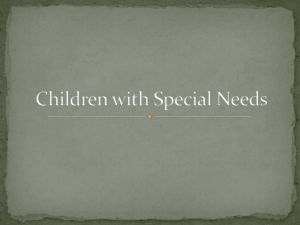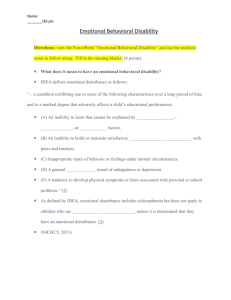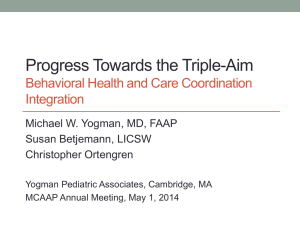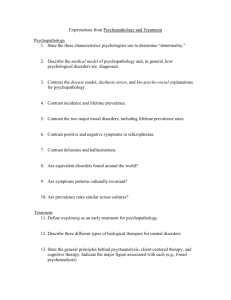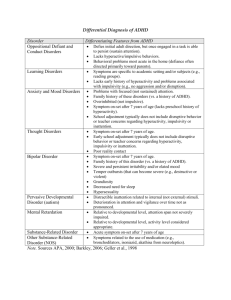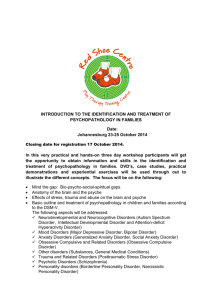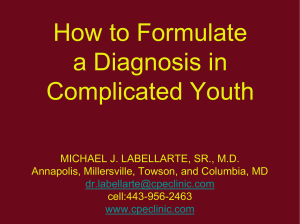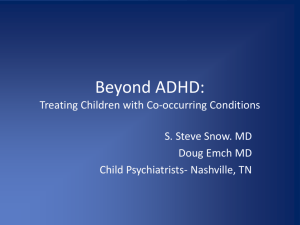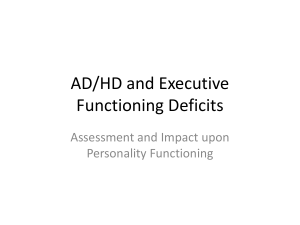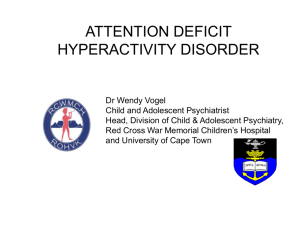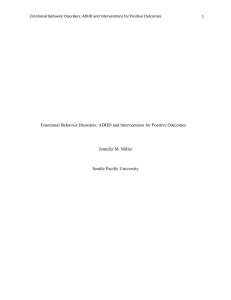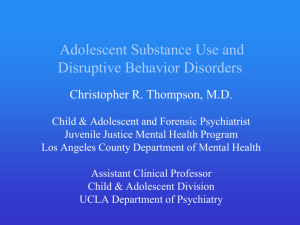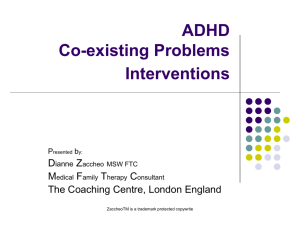Review for Midterm – Psychology of the Exceptional Child
advertisement
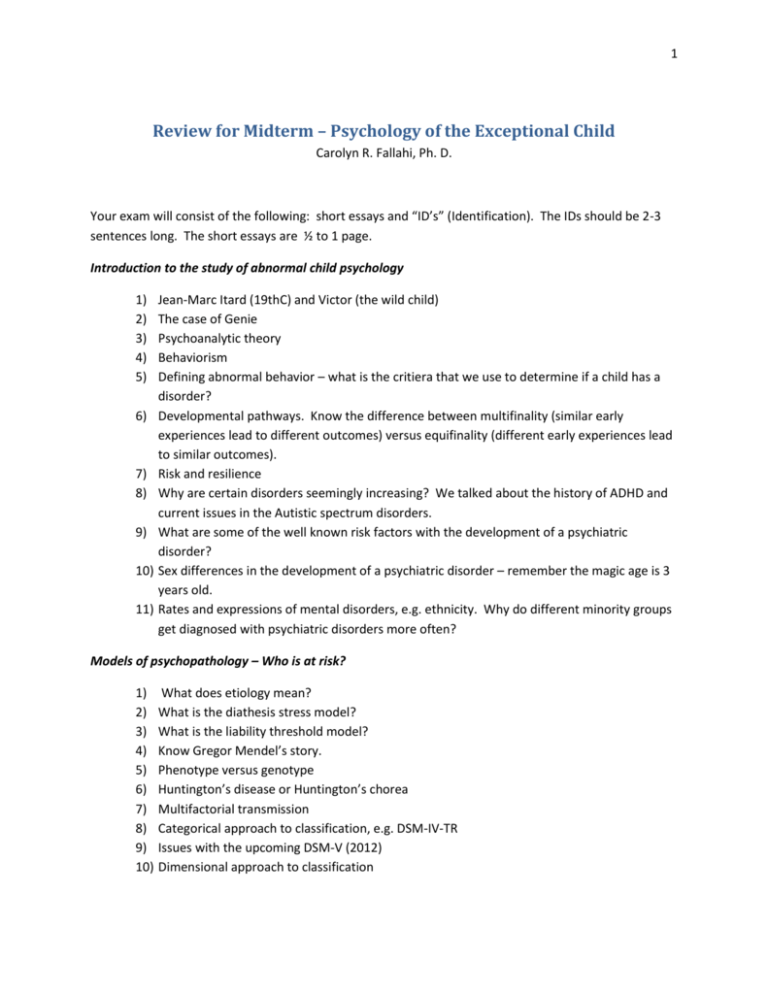
1 Review for Midterm – Psychology of the Exceptional Child Carolyn R. Fallahi, Ph. D. Your exam will consist of the following: short essays and “ID’s” (Identification). The IDs should be 2-3 sentences long. The short essays are ½ to 1 page. Introduction to the study of abnormal child psychology 1) 2) 3) 4) 5) 6) 7) 8) 9) 10) 11) Jean-Marc Itard (19thC) and Victor (the wild child) The case of Genie Psychoanalytic theory Behaviorism Defining abnormal behavior – what is the critiera that we use to determine if a child has a disorder? Developmental pathways. Know the difference between multifinality (similar early experiences lead to different outcomes) versus equifinality (different early experiences lead to similar outcomes). Risk and resilience Why are certain disorders seemingly increasing? We talked about the history of ADHD and current issues in the Autistic spectrum disorders. What are some of the well known risk factors with the development of a psychiatric disorder? Sex differences in the development of a psychiatric disorder – remember the magic age is 3 years old. Rates and expressions of mental disorders, e.g. ethnicity. Why do different minority groups get diagnosed with psychiatric disorders more often? Models of psychopathology – Who is at risk? 1) 2) 3) 4) 5) 6) 7) 8) 9) 10) What does etiology mean? What is the diathesis stress model? What is the liability threshold model? Know Gregor Mendel’s story. Phenotype versus genotype Huntington’s disease or Huntington’s chorea Multifactorial transmission Categorical approach to classification, e.g. DSM-IV-TR Issues with the upcoming DSM-V (2012) Dimensional approach to classification 2 11) Family research used for figuring out the genetic loading, e.g. identical versus fraternal twins, concordance rates 12) Can genes be modified? Understand the role of immediate early genes 13) Neural plasticity and the role of experience 14) Brandi Binder case 15) Research looking at rats in an enriched environment 16) David Snowden’s work with nuns 17) The research that links some disorders to malfunctions in parts of the developing brain, e.g. brain stem, thalamus, hypothalamus, cerebellum, forebrain, limbic system = all believed to be involved with psychopathology. Know the parts of the brain that we covered in class in regards to their function (not where they are located). 18) Neurotransmitters implicated in psychopathology, e.g. serotonin, benzodiazepine-GABA, norepinephrine, and dopamine. 19) Atrophy or pruning 20) Myelination 21) Other models that contribute to our understanding of psychopathology, e.g. behavioral and cognitive explanations, emotional influences (emotional reactivity or emotional regulation) Conducting research in childhood psychopathology 1) 2) 3) 4) 5) 6) 7) 8) 9) 10) 11) 12) 13) 14) 15) 16) 17) 18) 19) 20) Case studies The case of Dora Transference and countertransference The case of little Hans The three faces of Eve The Mask of Insanity Epidemiology Prevalence Incidence The liability threshold model (risk factors and protective factors that might lead to the development of a psychiatric disorder) Daniel Scruggs of Meriden CT Ho and Ha hypotheses Independent and Dependent variables Operationalizing your DV What are confounding variables? Can you get rid of confounding variables? Matching versus randomization What is an analog study? Know the different designs presented in class, e.g. ABAB, within subjects design, between subjects design, mixed designs Interviews, surveys, clinical interviews Cross-sectional versus longitudinal designs 3 21) Experiment 22) Correlational studies 23) Probability, p-values, statistical versus practical significance Ethical issues 1) We have a number of laws that govern psychologist’s conduct. What are some of those laws? (e.g. sexual contact, confidentiality, keeping records). 2) APA professional organization – what can they do if there is an ethical breech? 3) An understanding that ethical behavior reflects the culture – examples? 4) How do you handle an ethical situation when there is a difference between what the patient (child) wants and what the parent wants out of therapy? Remember the case of Karen. 5) Ethics involved in doing research with children, e.g. informed consent versus assent. 6) Know some of the horrible research practices in the history of our country, e.g. the 1896 study examining whether or not we could give a spinal tap without harm; how institutionalized children were experimented upon; the Tuskegee study; the Willowbrook state school study. 7) The famous Parham v. J. R. (1979) landmark case. 8) Know the basic APA principles for psychologists, e.g. beneficence vs. nonmaleficence. 9) What is confidential with children and what isn’t? 10) Can we force children to participate in research? Therapy? 11) IRB or HSC (Institutional Review Board or Human Subjects Committee). Assessment, classification, and treatment 1) Sigmund Freud and Psychoanalytic theory 2) Eros versus thantos 3) Methods Freud used for the treatment of hysteria, e.g. the talking cure, free association, dream interpretation, hypnosis. Later methods include projective tests, e.g. Rorschach, TAT, CAT, Incomplete sentences blank. Understand the theory behind projectives. 4) The structure of personality: preconscious, unconscious, conscious. 5) Catharsis 6) Id, ego, superego 7) The psychosexual stages of development 8) Fixation 9) The oedipal complex 10) Defense mechanisms 11) Carl Rogers and Person-Centered Therapy 12) Gloria 13) Congruence, unconditional positive regard, empathy 14) Self-actualization 15) The difference between psychoanalysis and Rogerian approaches? 4 16) 17) 18) 19) 20) 21) 22) Behavioral treatments, e.g. Pavlov, Watson, classical conditioning and operant conditioning Albert Ellis and RET The Dictionary of Disorders; Rosenhan’s article; Szaz’s article The antipsychiatry movement Issues related to diagnosis – are they reliable? Stigma, etc. DSM-IV-TR Why would psychologists want to classify a patient with the DSM? Behavioral disorders 1) Understand the symptoms involved with diagnosing Conduct Disorder (CD) and Oppositional Defiant Disorder (ODD) 2) Know the case study of the The Boston Boy Fiend 3) What are the issues with defining “bad behavior”? 4) Should ODD and CD be on a continuum? 5) Frick et al (1993)’s meta-analytic study of CD. 6) Problems with CD diagnosis, e.g. lack of developmental norms, the same diagnostic label being applied to children of very different behavioral presentations, not taking into account the environmental influences that might lead to the diagnosis of CD. 7) Associated problems with CD, e.g. intelligence, achievement, academics, problems with family and peers. 8) Common co-occurring diagnoses associated with CD. 9) Differences in behavioral presentation for boys versus girls. 10) Etiological explanations for CD, e.g. genetic and environmental explanations, birth complications, parental explanations, neurophysiological responding, temperament. 11) What are some of the treatments we use for CD? ODD? 12) Understand the symptoms involved with diagnosing ADHD. What are the different types or presentations? 13) What are the current issues with diagnosis? 14) What are the common co-occurring disorders associated with ADHD? 15) What are the common problems associated with ADHD?, e.g. intelligence, academics, emotion dysregulation, parent and peer problems, sleep problems, etc. 16) What is the developmental course of ADHD? 17) What are the genetic explanations for ADHD? Deficits in arousal? Brain structure abnormalities? Neurotransmitter research? Pregnancy and birth complications? 18) How do we treat ADHD?
